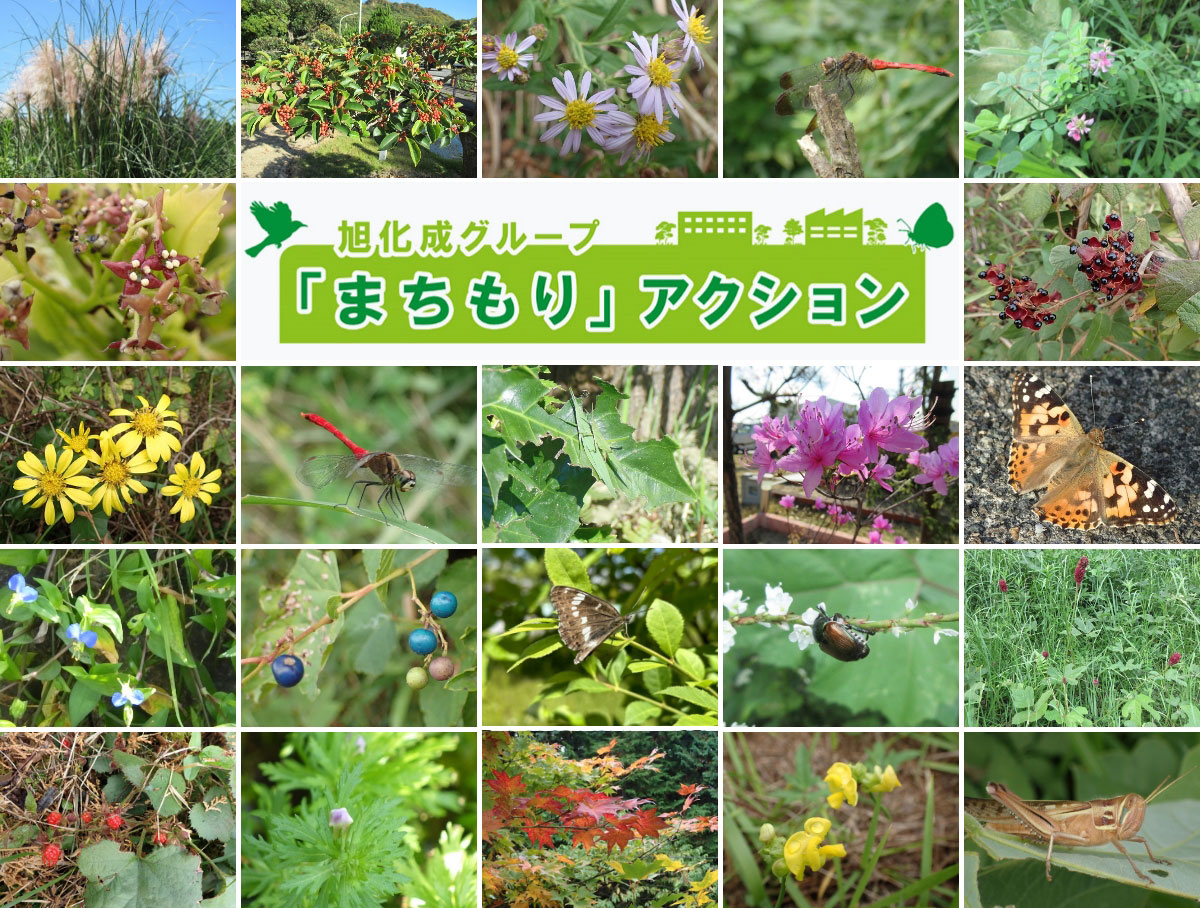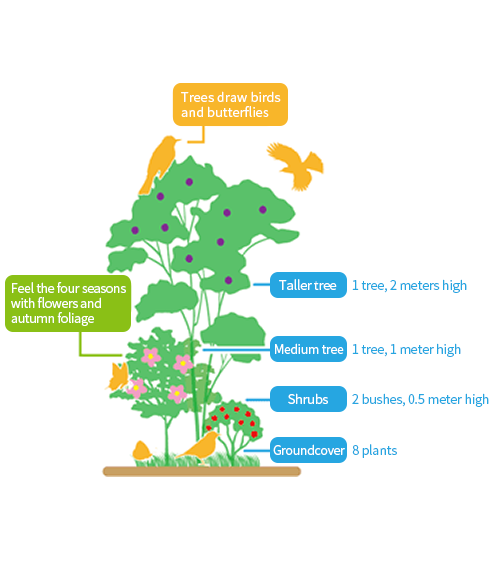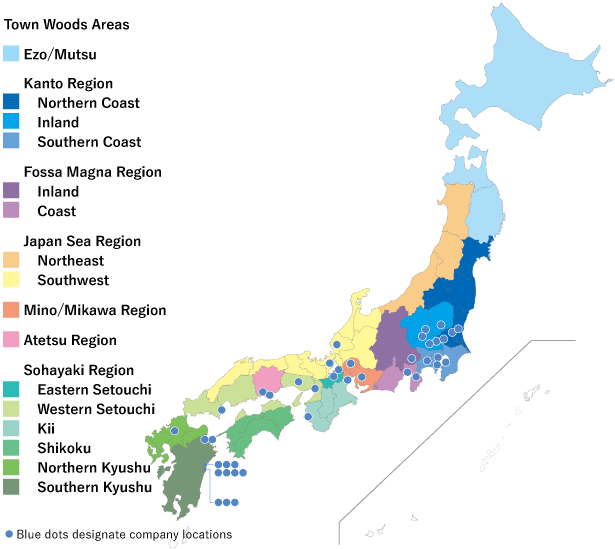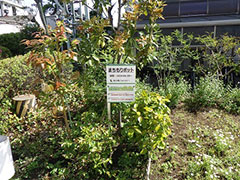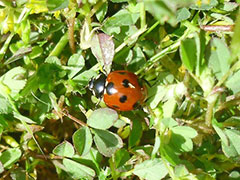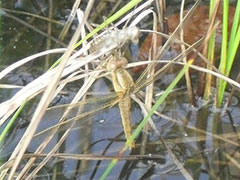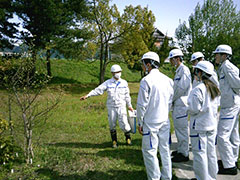Biodiversity
Policy
To ensure the sustainable utilization of living resources, the Asahi Kasei Group gives due consideration to reducing the impact of our business activities on biodiversity, and we have established guidelines for the preservation of biodiversity. Based on these guidelines, we have been working to understand the relationship between our business activities and biodiversity since 2010. In order to promote business activity mindful of biodiversity, we are working to raise awareness among personnel by various means including our ESH education program.
Assessment of nature-related risks and opportunities at Asahi Kasei Group production sites
The Asahi Kasei Group continues to make assessments in accordance with the LEAP approach, a method recommended by the TNFD* for evaluating nature-related risks and opportunities.
In the “Locate” phase, data from ENCORE, a tool recommended by the TNFD, was consulted to determine the magnitude of natural dependency and impact for each directly operated industrial process. The result of this analysis led to us focusing our evaluation on the Material sector, which has a large impact on nature and a large sales volume. In addition, priority areas for direct operation locations were evaluated according to five criteria set by the TNFD: conservation importance, ecological integrity, rapid degradation of ecological integrity, water stress, and magnitude of potential dependency and impact, referring to TNFD recommended tools such as IBAT, Resource Watch, and ENCORE.
In the “Evaluate” phase, we identified significant dependencies and impacts using information from the TNFD’s sector guidance on chemicals, ENCORE, peer ESG reports, and external reports. Moreover, in order to understand the magnitude of dependency and impact, we organized the environmental performance data we have collected and disclosed so far, and by referring to the data for each site, we identified the locations with the greatest dependency and impact.
In the “Assess” phase, we referred to the TNFD’s sector guidance on chemicals and related reports from international organizations, and identified risks and opportunities for nature on the six quadrants of supply chain (upstream, direct, downstream) and source (dependency, impact), and made a qualitative assessment in terms of magnitude, likelihood of occurrence, and time frame of occurrence. We have also organized the relationship with the areas we have been tackling such as “climate change,” “resource circulation,” and “pollution.”
Going forward, we will use these risks and opportunities for nature in our daily environmental management, and consider how to respond to these risks and opportunities during the “Prepare” phase.
- *Task Force on Nature-related Financial Disclosures, an international organization established in 2021 to build a framework for corporate risk management and disclosure regarding natural capital, etc.
Certification as a “site in harmony with nature”
Asahi Kasei has joined the 30by30 Biodiversity Alliance1 which was established by members of interested companies, local governments, and organizations in April 2022 in order to advance initiatives to gain OECM2 certification for areas safeguarded as company green spaces or under similar designations with the aim of achieving the 30by30 target. Asahi Woods of Life in Fuji City, Shizuoka Prefecture, was certified as a “Site in Harmony with Nature”3 in the first half of 2023.

- 1The 30by30 Alliance is an initiative to prevent and restore biodiversity losses while effectively preserving 30% or more of the Earth’s land and ocean area as healthy ecosystems by 2030.
- 2Other Effective area-based Conservation Measures is a designation for areas that contribute to conservation of biodiversity outside of protected areas.
- 3Site in Harmony with Nature is a system launched in fiscal 2023 by the Ministry of the Environment of Japan to certify areas where biodiversity is conserved with the support of local communities, etc., with 122 sites including the Asahi Woods of Life certified in 35 prefectures around Japan in the first year.
Group-wide activities for biodiversity
What is the "Town Woods" Program?
We aim to increase value from the perspective of biodiversity while enhancing green spaces at Asahi Kasei Group operating sites in Japan. We will use Town Woods Pots as a tool to heighten understanding and awareness of the value of biodiversity among personnel.
What are Town Woods Pots?
This new way of landscaping by Asahi Kasei Homes combines four layers of vegetation of varying heights: Tall, medium, short, and groundcover. While compact enough to integrate with urban residential areas, they increase the space for other plants and wildlife in artificial environments that otherwise have little greenery. Our Town Woods Program uses the phytosociological method to classify green spaces at operating sites throughout Japan, selecting the most suitable regional vegetation when creating the Town Woods plantings.
Town Woods Project: FY2019–2023 Results
- Note: Town Woods Points (Machi-Mori Point: MMP) Initiatives at the Group sites are divided into four stages. Each initiative earns Town Woods Points and the points are aggregated across the group.
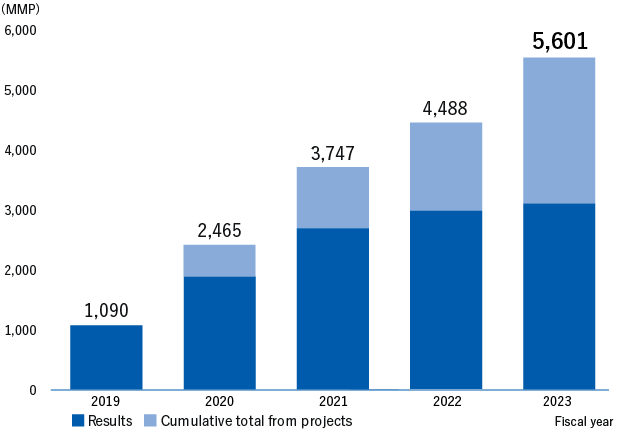 Cumulative Total of Town Woods Points
Cumulative Total of Town Woods Points
| Stage | Example Initiatives |
|---|---|
| Stage 1: Installation |
|
| Stage 2: Observation |
|
| Stage 3: Dissemination |
|
| Stage 4: Development Initiatives in other locations |
|
FY2023 Project: "Town Woods" Observing the Colors of Living Things
In fiscal 2023, we held a limited time project for employees to think about the strategies of living creatures by observing the colors of living things. The project provided an opportunity for employees to get closer to nearby nature such as green spaces inside the office, areas around our Town Woods Pots, home gardens, neighborhood parks, and on the roadside. For this initiative, employees were asked to submit color schemes and pattern features of plants and animals for the first period from July 16 to September 15, and the second period from September 16 to November 15.
As a result of this four-month effort, we were able to record 304 submissions (993 MMP), 146 plant species, and 63 animal species. After roughly dividing the colors of living things in all submitted photos into 14 colors, the most common color was “green,” followed by “yellowish green.” The most common flowers and fruits to be photographed were “white,” “yellow,” “purple,” “peach,” and “red,” which are colors that stand out to people. We learned that about 60% of all living things are thought to adopt conspicuous colors to appeal to someone, and 20% are thought to adopt subdued colors to hide themselves, with more living things adopting conspicuous colors for survival.
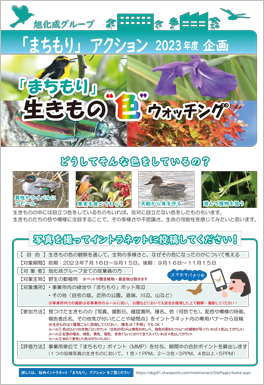
Notable activities in fiscal 2023
Actions in the Moriyama Area
Ex-situ conservation of smallhead stickleback, an endangered freshwater fish, and joint effort among companies and communities for dragonfly conservation
In Moriyama, we draw groundwater for industrial use in cooling equipment. Its quality is strictly monitored, and it is discharged to nearby rivers after use. A portion of the discharged water from our Moriyama Works is also used for agriculture, which has become vital for local farmers as well as wildlife inhabiting the waterfront areas. Against this backdrop, and since water is intrinsically related to our business operations, in fiscal 2010 we started initiatives to protect biodiversity with a focus on water resources.
In fiscal 2015, we began ex-situ conservation of smallhead stickleback, an endangered freshwater fish, and in fiscal 2016, we began dragonfly conservation activities in cooperation with companies that have operations located in Shiga Prefecture and local communities.
In fiscal 2023, we held a large-scale observation event at the biotope (Moribio) for employees, their families, and neighboring community associations, gathering 60 participants. Thanks to the support of experts, the observation sessions provided a good opportunity to learn about biodiversity conservation while having fun by observing smallhead sticklebacks and dragonflies living in the biotope, conducting a stamp rally for insects found, and creating a container biotope for dragonflies. Following the observation, a luncheon using foods locally produced for local consumption was held to show children the quality of Shiga Prefecture's foodstuffs.
In collaboration with companies that have operations located in Shiga Prefecture, we are involved in "Operation Dragonfly 100: Save Shiga's Dragonflies!" (sponsored by Biodiversity Biwako Network). This project involves working with local communities to survey the habitat of the dragonfly and to conserve it using a container biotope. In the Biodiversity Biwako Network, each company decides on a dragonfly to be promoted for conservation, and Asahi Kasei has been conserving the dragonfly Sympetrum kunckeli, which lives in wetlands. Unfortunately, we were unable to confirm the settling of adults in fiscal 2023, so we are planning to add a container biotope and release eggs in an attempt to successfully confirm adults’ settlements in fiscal 2024. The Biodiversity Biwako Network regularly hold exhibitions and events at the Lake Biwa Museum, providing opportunities for local residents to learn about our efforts and the importance of biodiversity conservation.
We will continue to work on biodiversity activities through conservation at the Moribio and activities at the Biodiversity Biwako Network.
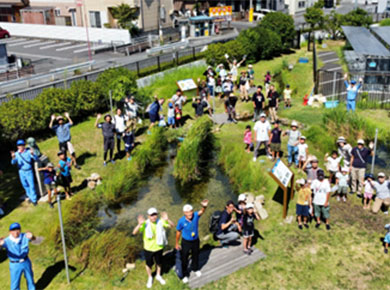 Observing wildlife at the Moribio
Observing wildlife at the Moribio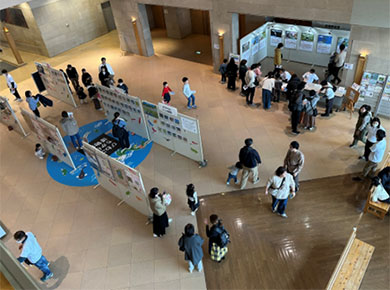 Exhibition at the Lake Biwa Museum
Exhibition at the Lake Biwa Museum
Actions by Asahi Kasei Jyuko Co., Ltd.
Project to rediscover living with the woods and water in Higashiomi
We are carrying out conservation works at Asahi Kasei Jyuko Co., Ltd.’s Shiga Plant—principally at the “Yuya Hebel Biotope” created on the plant’s grounds in June 2017—in aid of the four-spotted skimmer (our “nominated dragonfly”), a keystone species on the Shiga red list and which surveys of dragonflies in the surrounding area show to be at risk of extinction due to habitat degradation in recent years.
In fiscal 2023, we held an observation session at the “Yuya Hebel Biotope” for employees and their families for the first time in four years. The observation session provided an opportunity to learn about biodiversity conservation activities while having fun, as participants observed butterfly dragonflies (black) and darting dragonflies (red) living in the biotope, while receiving explanations and support from experts, in conjunction with the “Town Woods” Observing the Colors of Living Things event.
For the purpose of constructing a planting system that will allow the four-spotted skimmers that hatch in the biotope to stay and settle for a certain period of time, we are continuing to grow seedlings from the plants transplanted into pots around the biotope in June 2022, and plan to replant them around the biotope in one to two years.
 Observation at the “Yuya Hebel Biotope”
Observation at the “Yuya Hebel Biotope”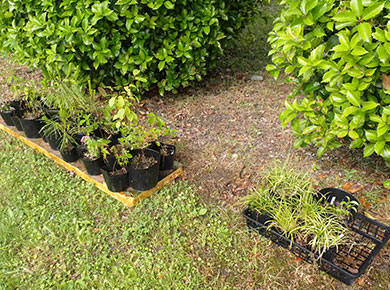 Seedling plants transplanted into pots and growing seedlings
Seedling plants transplanted into pots and growing seedlings
Actions in the Suzuka Area
A river known as River No. 19 cuts through the grounds of our Suzuka Works from north to south, and water used in the production line is discharged into this river with strict water-quality monitoring in place. Although the river is narrow, it supports much aquatic life that finds it easy to live there, protected by the old stone embankment. Around these cobblestone pavements and in the crevices, plants such as Limnophila sessiliflora grow, crabs inhabit, and various small fish including the pale chub swim in the river water, as dragonflies and butterflies visit the waterside. In the early morning when there are few people around, birds such as ducks, great blue herons, and egrets can be seen flying in and resting. This year, more than ten ducklings were seen swimming in a row behind parent ducks, which made participants feel relieved. The number of soft-shelled turtles, which have lived in the area for a long time, has increased to five, and they can sometimes be seen swimming with large movements of their arms and legs.
Employees look forward to seeing what kind of creatures they may find when walking by the river. Every time various creatures are found, we realize how important it is to maintain the riparian environment of River No. 19, home to many aquatic organisms. We will steadily preserve the cobblestone revetment and continue to ensure water quality control of the discharge water to conserve the environment so that these aquatic organisms can live peacefully.
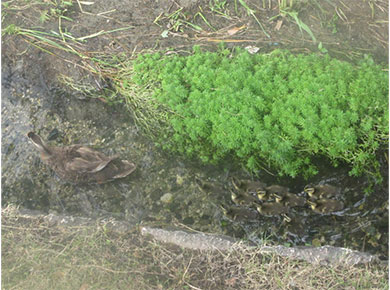 Ducks swimming by the Limnophila sessiliflora in River No. 19
Ducks swimming by the Limnophila sessiliflora in River No. 19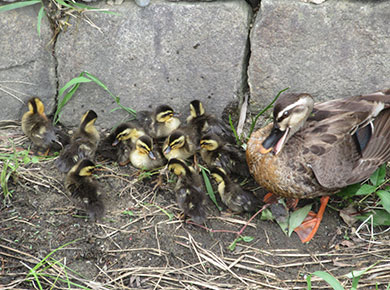 Parent ducks and ducklings relaxing on the shore of River No. 19
Parent ducks and ducklings relaxing on the shore of River No. 19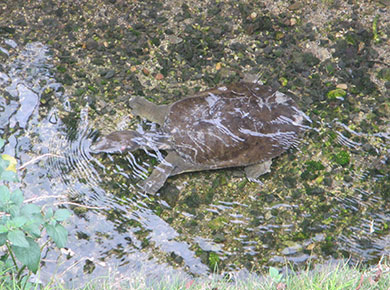 Turtles swimming in River No. 19
Turtles swimming in River No. 19
Actions in Nobeoka and Hyuga Area
Since 2007, Nobeoka office has participated in a reforestation program led by Miyazaki prefecture to create forests in cooperation with companies. We planted more than 48.52 hectares of broad-leaf trees and other trees native to the area, replacing plantations of cedar and cypress. This included 24.52 hectares in Hinokagecho, 20 hectares in Takachiho, 1 hectare in Gokase, and 3 hectares in Kitakatacho.
In the past, as many as 400 people took part in these tree-planting activities, but because of the pandemic they were put on hold for a while. However, activities were resumed in fiscal 2022 with the number of participants limited to approximately 150 people. In fiscal 2023, approximately 120 people took part and planted 1,500 trees on 1 hectare of land.
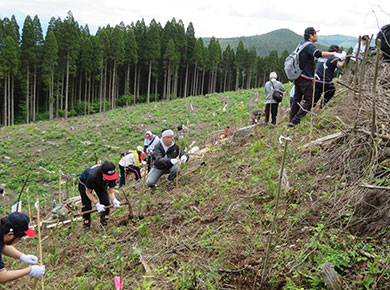 Planting trees
Planting trees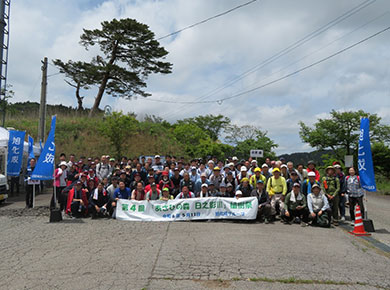 Commemorative photo after tree planting session
Commemorative photo after tree planting session
Please refer to the document below to see Asahi Kasei Homes initiatives.


